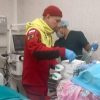
Danger zone — the "House of Horrors" training school in Chamchamal, Iraq
Credit: Sam Tarling
"Cooking pots are an Isis favourite, but basically any container that can hold explosives can be used as a booby trap," explains Karl Greenwood, an ex-Army bomb disposal expert from the Mines Advisory Group, a British mine clearance charity. "If that had gone off in real life, it would have ruined your day rather."
The charity faces a daunting task in Iraq, where IS planted booby traps and IEDs — improvised explosive devices — in tens of thousands of houses, public buildings, roadsides and fields. Between 2017 and 2019 alone, such bombs killed at least 231 people and injured 199, according to the Landmine Monitor database, although many other casualties may have gone unreported. A large number of the victims were civilians who had fled Isis’s rule and were returning home for the first time.

A mortar shell rigged up as an improvised explosive in the training school
Credit: Sam Tarling
The threat is now all the greater following a decision last month by the Iraqi government to shut dozens of camps for people made homeless by the conflict. There are fears that the camps could become IS recruiting grounds, but closing them means that tens of thousands of civilians may be tempted to return to booby-trapped homes.
The Mines Advisory Group has 750 mostly local staff working in Iraq — some clearing IS booby-traps, and others still clearing "legacy" landmines from the Iran-Iraq war nearly 40 years ago.
Among them is Pshtiwan Abdulrahman, 48, whom we meet during a clearance operation in the village of Chamakor, outside Mosul. His brother Farman, a soldier in the Iraq’s Kurdish Peshmerga forces, was killed by an Isis booby trap in 2015.
“I don’t want the pain of what happened to me to happen to anyone else,” he said. "“His death is a motivation for me.”

Mine Advisory Group team leader Pshtiwan Abdul Rahman, 48, in an abandoned building used as a makeshift headquarters by MAG de-miners in the village of Chamakor
Credit: Sam Tarling
In a line of work where one may not get the chance to learn from one’s mistakes, the simulated hazards in the "House of Horrors" offer vital training.
The house is a single-storey shack, typical of the villages around Mosul, where IS declared its short-lived "Caliphate" in 2014. Every room is rigged with booby-traps that Karl has set up, which the apprentices must spot, assess, and then defuse.
"I have basically taught myself to think like an Isis person," he grins, as we walk the path to the front porch, past a skull and crossbones warning sign. "But that’s the only way to make the training realistic."

At death's door — the pink plastic box contains explosives linked to a door-activated detonator
Credit: Sam Tarling
"Realistic" training also means making the booby traps very hard to spot. When I gingerly approach the villa’s front door, I can see no trip wires, suspicious electronics, or odd-looking packages.
One step further, though, and a warning alarm sounds. I’ve disturbed an infra-red sensor beam, wired to a mortar round that would probably have killed anyone in a 10-metre radius. Far from being some hi-tech military gadget, the infra-red beam is the sort used in household garage door sensors.
"You can get them in any hardware store," Karl adds. "Most of this stuff is just simple electronics — Isis could train people how to use it quite easily."
Indeed, the way he talks about IS’s various bomb-making ruses makes them sound rather like some demonic DIY cult. I learn that light sensors, fridge timers, and all manner of other home improvement gear can be used in bombs, as can TV remotes and PlayStation joysticks.

Deadly DIY — a display case of Isis booby trap trigger devices at MAG's training school in Chamchamal
Credit: Sam Tarling
A watchful booby-trap clearance operative may also be on the look-out for recent plastering work or grouting — a sign that bombs may have been planted in a wall or hidden under tiles. Another giveaway is packets of Duracell batteries, famous for their sales slogan: “no other battery looks like it or lasts like it”. This has made them an IS favourite for any trigger device requiring electricity.
The next room in the house is largely empty save for a bed and a small chest of drawers beside it. When I gently pull a draw open, I spot another mortar shell inside — but no alarm sounds. Instead, the shell is wired to a new pair of children’s boots next to the chest, placed there in the anticipation that some newly-returned villagers might grab them for their kids.
"A lot of these people have spent years in camps, and are returning home with very little money," Karl says. "Isis will booby-trap anything that might take people’s fancy."
Even for experts, the danger signs are not easy to see. With the house deliberately strewn with rubbish, battle debris and thick dust, it takes a very sharp eye to spot a trip wire running across a floor — let alone a pressure pad hidden under linoleum.

Mine Advisory Group (MAG) de-miners demonstrate a weighted device used for remotely breaking down booby-trapped doors, at the MAG base in Chamchamal,
Credit: Sam Tarling
Clearance teams carry out a laborious fingertip search, doing a single square metre at a time. Sometimes, they will even enter a room via the roof, windows or a hole drilled in the wall, inspecting what lies inside with mirrors and video cameras. Ropes and pulleys may be used to lift or pull objects from a distance, and a single building can take days to clear.
Karl, 57, learned his trade in the Army’s bomb disposal wing, where his duties included checking venues for bombs ahead of party conference season. Much of what he sees in Iraq are techniques he first saw used by the IRA, but applied even more ruthlessly. IS has, for example, planted numerous booby traps in schools around Mosul. "They didn’t want children to have an education, so schools are a target," he adds.
Children’s natural curiosity also puts them at risk. Three years ago, Ali Mustafa spotted a wire in the ground outside his home in the village of Zahra Khatoon Kabeer, near Mosul, and gave it a pull. It set off a booby trap that blew part of his hand off. "All I can remember is a huge bang," said Ali, now 14. "I still can’t use my hand to write with even now."

Ali Mustafa, 14, stands outside his home where three years ago he was injured by a hidden explosive left behind by ISIS, in the village of Zahra Khatoon Kabeer
Credit: Sam Tarling
Today, Ali’s village is largely clear of mines, with families able to farm safely again in nearby fields too. Clearing up IS’s deadly legacy, however, is not a job that can be done in a hurry. Iraq is the worst-affected country in the world for landmines and home-made bombs, with nearly 1,866 square kilometres of contaminated land. Last year, MAG and other agencies cleared 15.7 square kilometres. At current rates, it could be another century before they are all removed.
However, all the training in the world does not stop tragic accidents: two local MAG staff have been killed in the last five years. Given the difficult work they do, it’s amazing the number isn’t higher.





















































Свежие комментарии